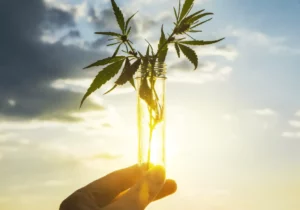People familiar with marijuana know that the plant can have two very
different effects. Sometimes, people who consume marijuana feel
pleasantly mellow and anxiety-free. Other times, marijuana consumption
results in paranoid feelings that leave the consumer less than relaxed.
Many people wonder how the same plant can produce two reactions that are
so very different. The answer comes down to brain chemistry and each
user’s individual experiences.
How Marijuana Affects the Brain
In order to understand why marijuana sometimes causes relaxation and
sometimes causes paranoia, it’s important to understand how the
compounds contained in marijuana affect the human brain. When marijuana
is consumed, the cannabinoids (such as THC) in the plant react with
receptors in the brain. Many of these receptors are located in the
amygdala, which is responsible for processing complex emotions such as
stress, fear, and paranoia. As the cannabinoids react within the brain,
they influence the function of the amygdala, causing a series of
emotions that can be either positive (relaxation and happiness) or
negative (paranoia and anxiety).
In some cases, cannabinoids like THC can overstimulate the brain,
leading to feelings of paranoia and anxiety. This is especially common
in people who are new to the use of medical marijuana. While nobody
knows exactly why THC produces anxious feelings on some occasions but
not on others, one working theory is that the human body relies on a
store of natural endocannabinoids that act very similarly to the
compounds found in medical marijuana.
The brains of people who have suffered trauma or intense stress have
been found to have lower levels of endocannabinoids. When individuals
with depleted endocannabinoid levels consume medical marijuana, the
cannabinoids contained within the plant replenish the body’s store of
endocannabinoids, which produces a relaxing effect. This may offer some
hint as to why marijuana makes some people feel relaxed and others
anxious. While further research is needed to solidify this connection,
researchers are optimistic about the potential treatments that this
connection may pose for people suffering from mood disorders.
Marijuana and Anxiety
The first thing to understand about the connection between marijuana and
anxiety is that a consumer’s pre-marijuana anxiety levels have a huge
effect on post-marijuana anxiety levels. According to a 2009
review
of several prominent cannabis and anxiety studies, people who use
cannabis frequently have higher anxiety levels than moderate users.
Additionally, these consumers generally show signs of anxiety disorders
before they show signs of cannabis dependence. Upon further review,
researchers interpreted these results to mean that people who are
naturally prone to anxiety tend to use cannabis as a means to cope with
that anxiety. This theory lies in direct opposition to the theory that
cannabis causes anxiety.
With those results in mind, however, it is important to remember that
the presence of anxiety is highly dependent upon many factors, including
the following:
- Family history
<!– –>
- Personality
<!– –>
- Gender
<!– –>
- A consumer’s personal history of paranoia or anxiety
When a consumer uses cannabis on a regular basis, other factors like the
frequency of cannabis use and the dose consumed can affect anxiety
levels as well. With that being said, researchers have noted that people
who use marijuana on a regular basis actually see a decrease in anxiety
levels. As a general rule, new users or those who consume a high level
of THC are more likely to experience marijuana-induced paranoia or
anxiety.
Avoiding Paranoia and Anxiety When Using Marijuana
Despite the fact that marijuana and anxiety are highly individualized,
there are things consumers can do to avoid marijuana-induced spells of
anxiety and paranoia. These include the following:
- Consumers who are new to marijuana or have experienced anxiety and
paranoia while using cannabis in the past should opt for a strain
that is low in THC and/or high in
CBD.
Because CBD is non-psychoactive, it’s likely to decrease anxiety and
produce a more relaxed and lucid experience.
<!– –>
- Regardless of whether a consumer is an experienced marijuana user or
not, it’s important to be careful about doses while
consuming marijuana. As a general rule, it’s more difficult to
control the dose of
oils
and
edibles
than it is
vaporizing
or smoking. Consumers who have had poor experiences with marijuana
in the past should consider smoking or vaporizing and upping the
intake dose slowly to avoid uncomfortable episodes.
<!– –>
- One of the best ways to avoid marijuana-induced anxiety and paranoia
is to always consume cannabis products in a comfortable and
calm space. Selecting to use these products at home rather than in a
crowded setting can help consumers reduce the likelihood of
marijuana-induced paranoia naturally.
<!– –>
- Consumers who are having difficulty avoiding anxiety even after
trying the above tips should consider changing the strain of
marijuana consumed. While this may seem like a simple tip, every
strain of marijuana offers a different selection of chemicals, which
affect the body differently. Consumers shouldn’t be afraid to
experiment with different
strains
to determine which ones work best for their personal preferences
and needs. When experimenting with new strains, consumers should
remember that Sativa strains generally produce a more active
experience while Indica strains are known to be more mellow
and relaxed.
While marijuana-induced anxiety and paranoia do occasionally happen,
there are steps consumers can take to avoid these negative emotions. By
being educated about how marijuana affects the brain and knowing what to
do to limit the risk of anxiety and paranoia, consumers can be proactive
about ensuring a positive marijuana experience every time.






